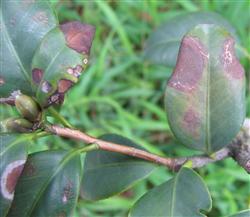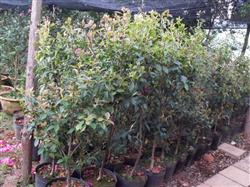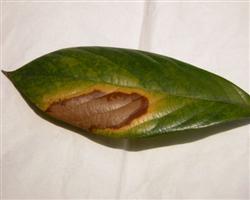What diseases do camellias have to control?

What are the diseases of camellias to be controlled? How should prevention and control be carried out? Please introduce the diseases of camellias to be controlled are: anthracnose [etiology and symptoms] the disease is caused by the infection of camellia leaves by Alternaria alternata. This is the main disease of camellias, with an incidence of 33%. The disease often occurs at the leaf margin, leaf tip and both sides of the leaf vein. Dark green markings appear at first, and then gradually expand into irregular Taipan, the color from brown to black, serious can spread to the whole leaf, causing a large number of fallen leaves. The occurrence of the disease is closely related to temperature and temperature. In general, the optimal temperature for the disease was 25-28 ℃. When the temperature is suitable and the humidity increases, especially the continuous rainfall, it can promote the spread and development of the disease. Generally, the disease began in April, reached the peak from June to July, and tended to stop after September. [prevention and treatment methods] ① completely removed the diseased leaves. ② cut off the diseased branches in winter. ③ sprays 1% Bordeaux solution every half a month before the onset of the disease each year. ④ was sprayed with 600-fold chlorothalonil solution once a week for 3 consecutive 4 times. ⑤ strengthens cultivation management, scientific weeding and fertilization. Phosphorus and potassium fertilizer can be increased in spring, and 0.15% potassium dihydrogen phosphate aqueous solution is sprayed before the leaves are unfolded. This disease is the most serious, which may cause the leaves to fall off and lead to death. My own experience is that for potted plants at home, in the hot summer season, especially flowers and trees with severe water evaporation, such as camellias, you should worry more about high temperature and dryness, be sure to pour enough water, and spray water on the leaves to cool down (but not over waterlogging) to prevent the disease from happening. Algal class disease [etiology and symptoms] the disease is caused by parasitic rust algae. Disease spots can appear on both sides of the leaf, but mainly on the leaf surface. At the beginning, it was a small gray-green dot in the shape of a needle, and then gradually expanded outward in the form of radiation, forming an approximate round or irregular spot. The disease spot is obviously raised, and there are fine striped felt on the surface. In the later stage, the color of the lesion changed from grayish green to dark brown. Due to the cover of pathogens, the foliar photosynthesis is affected, which weakens the growth of camellia plants. [incidence regularity] parasitic rust algae overwintered as filamentous nutrients in parasitic tissue, produced zoospores under wet conditions, and spores invaded new plants to make them get sick. The pathogen is a weak parasite. Under the condition of high temperature and high temperature, the disease is the most serious in camellias which grow poorly due to poor ventilation and light transmission. [control methods] ① should strengthen cultivation management, reasonable fertilization and timely pruning to avoid excessive shade of camellias and achieve ventilation and light transmission, so as to improve camellias resistance. ② can be prevented by spraying 0.2%-0.5% copper sulfate solution. Withered branch disease [etiology and symptoms] A disease caused by pathogenic fungi infecting young or old branches of camellia. The damaged branches were necrotic, the leaves changed from green to yellowish, dried up and fell off gradually from the top down, and finally the whole branch withered and died. The occurrence of the disease is that with the rise of the temperature in spring, the pathogen overwintering on the withered tree gradually matures and spreads to the nearby camellia branches with the wind. from new buds, twig wounds, leaf scars, grafting or pruning wounds, invade tea trees and multiply in large numbers. [control methods] ① cut off diseased and withered branches in winter and burned them centrally. ② removed useless adventitious buds and weak branches to reduce the epiphytic sites of pathogens. The infected plants were isolated and maintained by ③. Before sprouting and sprouting of camellia plants, ④ was sprayed with thiram, thiram, chlorothalonil and other fungicides, especially to ensure that the branches were sprayed at the wound. ⑤ applied more phosphorus and potassium fertilizer and less nitrogen fertilizer. However, this is not the most frequent season for the disease. Red leaf spot (red leaf blight) [etiology and symptoms] the disease is caused by Phyllosticta sp. Caused by fungi. The disease spot mostly occurs on the tender leaves, which is a light brown round watery spot at the beginning. After that, the disease spot spread, the color changed from light brown to brown, and sometimes several disease classes synthesized larger patches or spread to the whole leaf, causing a large number of scorched and shedding leaves. [incidence regularity] the pathogen lives on the diseased body of the host, and the spores spread by means of wind, rain, running water and so on. The disease generally began to occur in May, and the peak of the disease was from July to September, and a large number of damaged leaves fell off. [prevention and treatment methods] at the initial stage of the onset of ①, 70% methyl topiramate 1,500 times or 25% carbendazim 400 times can be sprayed for prevention and treatment. During drought, ② can increase leaf water spraying to restrain the occurrence of disease. My own pot of camellias got this disease some time ago. Days of high temperature, water evaporation and dry soil made me sick. I immediately watered it once a day, especially at night, and sprayed a lot of water on the leaves. I didn't use any potion. As a result, the symptoms were immediately relieved and were cured in less than a week. In the past few days, I have re-smoked a lot of new leaves, which looks a lot good for a while. Bituminous coal disease [etiology and symptoms] the disease is caused by aphids and scale insects. The damaged camellia leaves are covered with a layer of bacterial hyphae, forming a black "bituminous coal" layer, which hinders the normal photosynthesis and gas exchange of camellia plants and seriously hinders their growth and development. [incidence regularity] the pathogen likes the environmental conditions of low temperature and high humidity, and the temperature of 10 to 20 ℃ is the most suitable for the growth of the pathogen. In this temperature range, the higher the temperature, the faster the germs propagate and spread. The camellia forest with long-term weeds, high humidity and poor light is conducive to the occurrence and spread of the disease. [control methods] the pests causing bituminous coal disease are mainly aphids and scale insects. Therefore, in order to control this disease, we must first control the camellia aphids and scale insects. For the above diseases, you can judge according to the symptoms and take measures. Click to get more camellia planting techniques click to get more flowers and trees planting techniques
- Prev

How do camellias propagate and grow?
How do camellias propagate and grow? Please introduce the methods of propagation and planting of camellias with reference to the following methods: 1. Cutting in the rainy season from May to June, select the young mother tree, cut one-year-old twigs from the top, about 10cm, remove the lower leaves, flatten with a blade at the bottom of the node, and keep the top.
- Next

How to control Magnolia leaf blight?
How to control Magnolia leaf blight? Please introduce the main symptoms of Magnolia leaf blight occur on the leaves, serious can spread to petioles, buds. The disease spots mostly occur at the leaf margin, the initial stage is faded green macula, water stains, many disease spots even into pieces, fan shape outward expansion, black brown edge, gray yellow inside, can lead to...
Related
- Fuxing push coffee new agricultural production and marketing class: lack of small-scale processing plants
- Jujube rice field leisure farm deep ploughing Yilan for five years to create a space for organic food and play
- Nongyu Farm-A trial of organic papaya for brave women with advanced technology
- Four points for attention in the prevention and control of diseases and insect pests of edible fungi
- How to add nutrient solution to Edible Fungi
- Is there any good way to control edible fungus mites?
- Open Inoculation Technology of Edible Fungi
- Is there any clever way to use fertilizer for edible fungus in winter?
- What agents are used to kill the pathogens of edible fungi in the mushroom shed?
- Rapid drying of Edible Fungi

